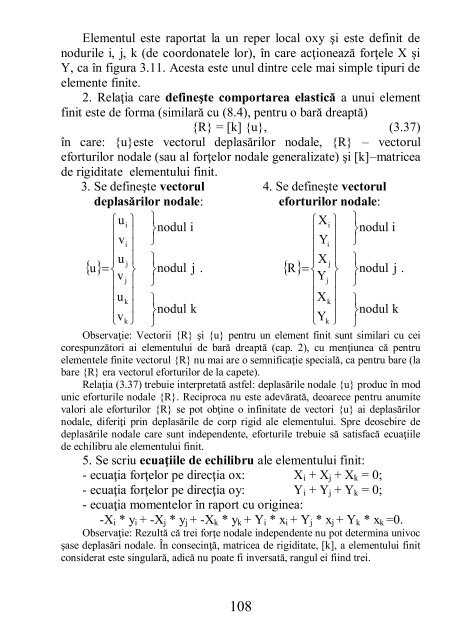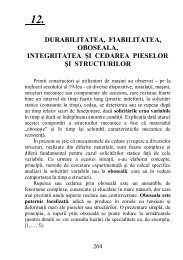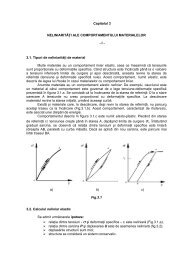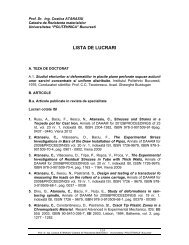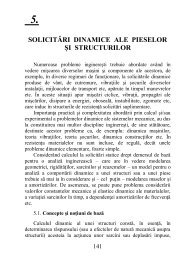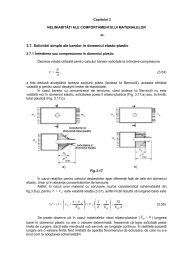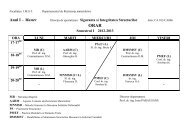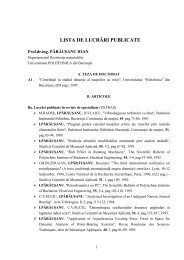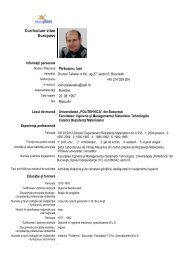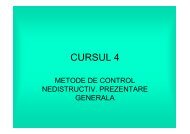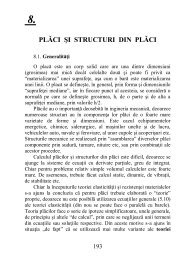4. Metode de calcul energetice Åi aproximative în rezistenÅ£a ...
4. Metode de calcul energetice Åi aproximative în rezistenÅ£a ...
4. Metode de calcul energetice Åi aproximative în rezistenÅ£a ...
You also want an ePaper? Increase the reach of your titles
YUMPU automatically turns print PDFs into web optimized ePapers that Google loves.
Elementul este raportat la un reper local oxy şi este <strong>de</strong>finit <strong>de</strong><br />
nodurile i, j, k (<strong>de</strong> coordonatele lor), în care acţionează forţele X şi<br />
Y, ca în figura 3.11. Acesta este unul dintre cele mai simple tipuri <strong>de</strong><br />
elemente finite.<br />
2. Relaţia care <strong>de</strong>fineşte comportarea elastică a unui element<br />
finit este <strong>de</strong> forma (similară cu (8.4), pentru o bară dreaptă)<br />
{R} = [k] {u}, (3.37)<br />
în care: {u}este vectorul <strong>de</strong>plasărilor nodale, {R} – vectorul<br />
eforturilor nodale (sau al forţelor nodale generalizate) şi [k]–matricea<br />
<strong>de</strong> rigiditate elementului finit.<br />
3. Se <strong>de</strong>fineşte vectorul <strong>4.</strong> Se <strong>de</strong>fineşte vectorul<br />
<strong>de</strong>plasărilor nodale:<br />
eforturilor nodale:<br />
u<br />
<br />
i<br />
<br />
nodul i<br />
X<br />
<br />
i<br />
<br />
<br />
v<br />
nodul<br />
i<br />
i<br />
<br />
<br />
<br />
Yi<br />
<br />
<br />
u<br />
<br />
j <br />
X<br />
<br />
j <br />
u<br />
<br />
<br />
v<br />
nodul<br />
j .<br />
R<br />
<br />
<br />
j<br />
<br />
Y<br />
nodul<br />
j .<br />
j<br />
<br />
u<br />
<br />
k <br />
X<br />
<br />
k <br />
nodul k<br />
v<br />
<br />
nodul k<br />
k <br />
Y<br />
<br />
k <br />
Observaţie: Vectorii {R} şi {u} pentru un element finit sunt similari cu cei<br />
corespunzători ai elementului <strong>de</strong> bară dreaptă (cap. 2), cu menţiunea că pentru<br />
elementele finite vectorul {R} nu mai are o semnificaţie specială, ca pentru bare (la<br />
bare {R} era vectorul eforturilor <strong>de</strong> la capete).<br />
Relaţia (3.37) trebuie interpretată astfel: <strong>de</strong>plasările nodale {u} produc în mod<br />
unic eforturile nodale {R}. Reciproca nu este a<strong>de</strong>vărată, <strong>de</strong>oarece pentru anumite<br />
valori ale eforturilor {R} se pot obţine o infinitate <strong>de</strong> vectori {u} ai <strong>de</strong>plasărilor<br />
nodale, diferiţi prin <strong>de</strong>plasările <strong>de</strong> corp rigid ale elementului. Spre <strong>de</strong>osebire <strong>de</strong><br />
<strong>de</strong>plasările nodale care sunt in<strong>de</strong>pen<strong>de</strong>nte, eforturile trebuie să satisfacă ecuaţiile<br />
<strong>de</strong> echilibru ale elementului finit.<br />
5. Se scriu ecuaţiile <strong>de</strong> echilibru ale elementului finit:<br />
- ecuaţia forţelor pe direcţia ox: X i + X j + X k = 0;<br />
- ecuaţia forţelor pe direcţia oy: Y i + Y j + Y k = 0;<br />
- ecuaţia momentelor în raport cu originea:<br />
-X i * y i + -X j * y j + -X k * y k + Y i * x i + Y j * x j + Y k * x k =0.<br />
Observaţie: Rezultă că trei forţe nodale in<strong>de</strong>pen<strong>de</strong>nte nu pot <strong>de</strong>termina univoc<br />
şase <strong>de</strong>plasări nodale. În consecinţă, matricea <strong>de</strong> rigiditate, [k], a elementului finit<br />
consi<strong>de</strong>rat este singulară, adică nu poate fi inversată, rangul ei fiind trei.<br />
108


